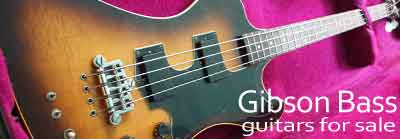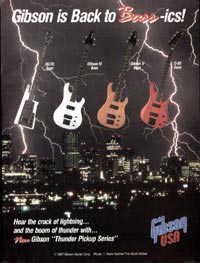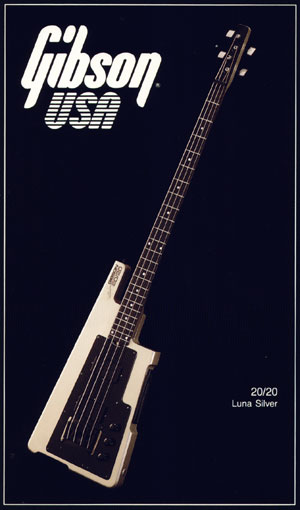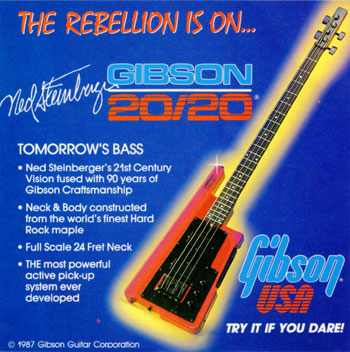
Ned Steinberger launched the guitar company bearing his name in New York in 1979. He produced a series of instruments with radically modern construction and design: typically saving weight and improving balance by utilising composite necks without headstocks. Many instruments were constructed entirely of man-made materials; the L-series basses were "molded composites of carbon and glass-fibre reinforced plastic". These non-wood instruments were strong; necks did not warp and no truss rod was required. There was, however, an impact on sound. Steinberger instruments had, according to company issued literature "exceptionally brilliant tone, rich in harmonics, with very long sustain". Detractors found it to be unnaturally clean.

In terms of design, Steinberger instruments were also highly original. The shape of the L-series basses was minimalist to say the least. A small rectangular body with headless neck, tuning performed at the body end of the strings; strings themselves having matching ball ends. Perfect for the future-facing synth generation of the 1980s.
Then in 1987, the company was acquired by Gibson. Gibson itself had changed hands only a year earlier, and the new owners were clearly looking to the future. Ned Steinberger stayed on for some time in an advisory role, designing the new 2020 bass in this time.
The 20/20 took some of Steinberger's stylistic approach, but mixed it with Gibson tradition. This bass looked like a Steinberger with it's angular, futuristic body, but was actually made entirely of wood. A hard rock maple body and neck, matched with a 24 fret two-octave ebony fretboard. There was a headstock, but it was tiny compared to every other Gibson before or since. Gibson used their existing wedge bridge design (requiring regular bass strings) with tuning performed the traditional Gibson way. Interestingly the tuning pegs have a different arrangement to other Gibson basses, instead of the usual EADG layout clockwise around the headstock, they run AEGD.
The bass also had new active humbucking pickups with 'Gibson' in gold on their covers. The requisite 9 volt battery was situated in a small cavity just beyond the bridge.
The 20/20 appeared in two catalogues, the 1987, and as reproduced here, the 1988 Gibson catalogue. This one is finished Luna Silver.
Gibson 20/20 in action
The 20/20 is an outstanding bass. It has a very wide tonal palette, two octave range, and doesn't weigh too much either. Controls are very simple: a volume control for each pickup, and a master tone. The pickups are strong, without being brash, offering a lot of very useable sounds. It has a number of innovative features, such as the adjustable nut, and hinged 'arm' for easy balance when seated. It really is an inspiring bass to play. Check out the Gibson 20/20 demo videos.

Gibson 20/20 shipping data
No shipping data has been released for the 20/20 bass, and the manufacturing period seems to have been fairly short. It would seem that production was in tens rather than hundreds. Originally, basses were shipped with a Gibson-branded softcase with no hard case available.
The 20/20 bass shipped in a specially designed gig bag with the typical late 1980s 'Gibson USA' logo. No hard case was available for this bass.
So why did it fail commercially? It was a well-built, highly functional instrument, combining the best features of both marques? One can only assume, like the Flying V three decades earlier, it was just the wrong design for the time.
The 1987 advertisement on the right proclaims 'The Rebellion is On...', 'Try it if you Dare' and 'THE most powerful active pick-up system ever developed'.
Have a closer look at 1987 Gibson 20/20 bass.




